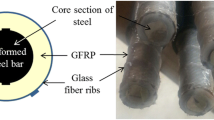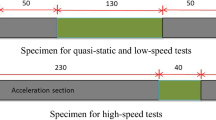Abstract
Damage mechanism evaluation of polymer matrix composites reinforced with glass fibers via Arcan test has become a very vital research area for determining the weak part of composite structures in aircraft segments. So, the objective of the present article is to study the effect of changing different load angles as: α = 0°, 15°, 30°, 45°, 60°, 75°, and 90° of unidirectional glass-fiber-reinforced polymer matrix composite specimens by Arcan test. In this study, modified Arcan test specimens (butterfly shaped) are used to study the mechanical properties and the resulting fracture mode of unidirectional glass-fiber-reinforced polymer matrix composite under combined tension and shear stresses. Two cases of applied Arcan test specimens of unidirectional glass-fiber-reinforced polymer matrix composite specimens were evaluated: (1) notch-to-notch perpendicularly oriented fiber specimens are referred to as group A1, and (2) notch-to-notch longitudinally oriented fiber specimens are group A2. The results revealed that the shear modulus of A1 specimens is found to be G12 = 5.5 GPa ± 18%, which is close to the value calculated using the elastic properties of the composite components. On the other hand, the shear modulus of A2 specimens is found to be G21 = 4.2 GPa ± 8%, which is relatively close to calculated G23 value. It is observed that the fracture mode of A2 specimens is almost not affected by the loading direction. However, the number of cracks and its direction relative to the notch-to-notch line decreases as the test angle increases. Moreover, the strength of A1 specimens is much higher than that of A2 specimens at all applied loading angles, except for pure shear loading.












Similar content being viewed by others
References
L. Arcan, M. Arcan, M. Daniel, SEM fractography of pure and mixed-mode interlaminar fractures in graphite/epoxy composites. Fractogr. Mod. Eng. Mater. Compos. Met. ASTM STP 948, 41–67 (1987)
M. Arcan, Z. Hashin, A. Volosin, A method to produce uniform plane-stress states with applications to fibre-reinforced materials. Exp. Mech. 18, 141–146 (1978)
M.H. Ata, M. Abu-Okail, G. Essa, Failure mode and failure load of adhesively bonded composite joints made by glass fiber-reinforced polymer. J Fail. Anal. Prevent. 19, 950–957 (2019)
B.S. Majumdar, D. Hunston, Continuous Parallel Fiber Composites: Fracture. Encyclopedia of Materials: Science and Technology (Elsevier, Amsterdam, 2001), pp. 1618–1629
Bert De Schoenmaker, Sam Van der Heijden, Ives De Baere, Wim Van Paepegem, Karen De Clerck, Effect of electrospun polyamide 6 nanofibres on the mechanical properties of a glass fibre/epoxy composite. Polym. Test. 32, 1495–1501 (2013)
C. Katsoulis, B.K. Kandola, P. Myler, E. Kandare, Post-fire flexural performance of epoxy-nanocomposite matrix glass fibre composites containing conventional flame retardants. Compos. A 43, 1389–1399 (2012)
H. Pihtili, An experimental investigation of wear of glass fibre–epoxy resin and glass fibre–polyester resin composite materials. Eur. Polym. J. 45, 49–154 (2009)
Hossein Ghiasi, Damiano Pasinib, Larry Lessard, Optimum stacking sequence design of composite materials. Part I: constant stiffness design. Compos. Struct. 90, 1–11 (2009)
S.C. Hung, K.M. Liechti, An evaluation of the Arcan specimen for determining the shear moduli of fiber reinforced composites. Exp. Mech. 37(4), 460–468 (1997)
S.C. Hung, K.M. Liechti, Finite element analysis of the Arcan specimen for fiber reinforced composites under pure shear and biaxial loading. J. Compos. Mater. 33(14), 1288–1317 (1999)
I.F. Soykok, O. Sayman, A. Pasinli, Effects of hot water aging on failure behavior of mechanically fastened glass fiber/epoxy composite joints. Compos. B 54, 59–70 (2013)
A.K. Kaw, Mechanics of composite materials, 2nd edn. (Taylor & Francis Group LLC, London, 2006), pp. 1–57
Kimiyoshi Naito, Yutaka Kagawa, Kanshi Kurihara, Dielectric properties and noncontact damage detection of plain-woven fabric glass fiber reinforced epoxy matrix composites using millimeter wavelength microwave. Compos. Struct. 94, 695–701 (2012)
L.P. Borrego, J.D.M. Costa, J.A.M. Ferreira, H. Silva, Fatigue behaviour of glass fibre reinforced epoxy composites enhanced with nanoparticles. Compos. B 62, 65–72 (2014)
Lei Gao, Fujian Ni, Andrew Braham, Hailong Luo, Mixed-mode cracking behavior of cold recycled mixes with emulsion using Arcan configuration. Constr. Build. Mater. 55, 415–422 (2014)
M. Nikbakht, N. Choupani, Fracture toughness characterization of carbon-epoxy composite using Arcan specimen. World Acad. Sci. Eng. Technol. 41, 738–744 (2008)
Naghdali Choupani, Mixed-mode cohesive fracture of adhesive joints: experimental and numerical studies. Eng. Fract. Mech. 75, 4363–4382 (2008)
P.B. Gning, D. Delsart, J.M. Mortier, D. Coutellier, Through-thickness strength measurements using Arcan’s method. Compos. B 41, 308–316 (2010)
B.W. Rosen, A simple procedure for experimental determination of the longitudinal shear modulus of unidirectional composites. J. Compos. Mater. 6, 552 (1972)
V. Krishnaraj, R. Zitoune, J.P. Davim, Drilling of Polymer-Matrix Composites (Springer, Berlin, 2013), pp. 3–9
A. Voloshin, M. Arcan, Failure of unidirectional fiber reinforced materials—new methodology and results. Exp. Mech. 20(3), 280–284 (1984)
A. Voloshin, M. Arcan, Pure shear moduli determination in fibre reinforced materials. Fibre Sci. Technol. 13, 125–134 (1980)
J.M. Whitney, D.L. Stansbarger, H.B. Howell, Analysis of the rail shear test—applications and limitations. J. Compos. Mater. 5, 24–34 (1971)
Acknowledgments
The authors are thankful to Manufacturing Engineering Department, Modern Academy for Engineering and Technology, Egypt, Cairo in Maadi and both of Mechanical Production Department, Faculty of Industrial Education, Beni-Suef University and Suez University, Egypt in Beni-Suef and Suez to cooperate and contribute this work.
Author information
Authors and Affiliations
Corresponding author
Additional information
Publisher's Note
Springer Nature remains neutral with regard to jurisdictional claims in published maps and institutional affiliations.
Rights and permissions
About this article
Cite this article
Abu-Okail, M., Nafea, M., Ghanem, M.A. et al. Damage Mechanism Evaluation of Polymer Matrix Composite Reinforced with Glass Fiber via Modified Arcan Test Specimens. J Fail. Anal. and Preven. 21, 451–461 (2021). https://doi.org/10.1007/s11668-020-01078-3
Received:
Revised:
Accepted:
Published:
Issue Date:
DOI: https://doi.org/10.1007/s11668-020-01078-3




